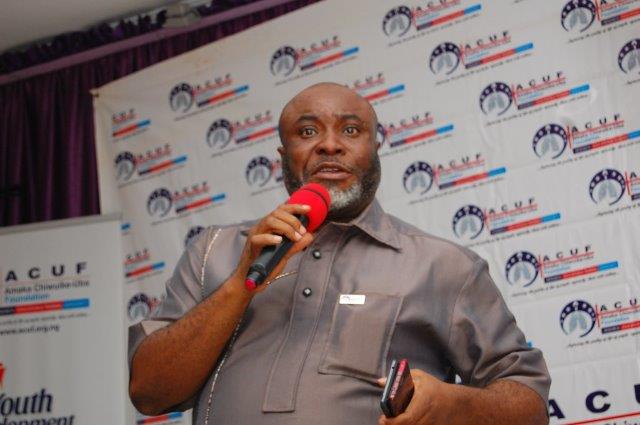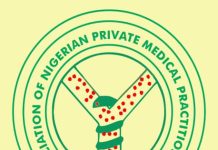🌿 Ruzu Non-Alcoholic Herbal Bitters
Ruzu Non-Alcoholic Herbal Bitters is a natural health supplement specially formulated to:
- ✅ Promote general wellness
- ✅ Detoxify the body
- ✅ Support the treatment of various ailments
Made from a powerful blend of 100% organic and medicinal herbs, Ruzu is completely alcohol-free, making it ideal for:
- 👪 All age groups
- 🌱 Health-conscious individuals
- 🌿 Anyone seeking non-alcoholic herbal remedies
Whether you're looking to boost your vitality, cleanse your system, or support healing the natural way, Ruzu Bitters offers a trusted herbal solution.
Nigeria is at a pivotal point as the globe observes globe COPD Day on November 19, 2025. The long-term, progressive, and avoidable respiratory condition known as chronic obstructive pulmonary disease (COPD) is quietly placing a significant strain on the country’s economy, society, and health. However, in public policy discourse, it is still poorly understood, underdiagnosed, and underprioritized.
On this day, the Amaka Chiwuike-Uba Foundation (ACUF) and the Global Allergy & Airways Patient Platform (GAAPP) remind us that COPD is not only a medical problem but also a governance issue that requires immediate, concerted action.
The burden of COPD in Nigeria is not merely hypothetical. According to a systematic evaluation of eight epidemiological studies, the median prevalence, as determined by spirometry—the gold standard for diagnosis—is roughly 9.2%, with an interquartile range of 7.6 to 10.0%.
On the other hand, a lower but very variable median prevalence of 5.1 percent with an interquartile range of 2.2 to 15.4 percent was observed in studies that used non-spirometric definitions, such as clinical diagnosis or British Medical Research Council standards. These numbers indicate a quiet epidemic that affects millions of people; they are neither marginal nor unimportant.
The pattern across demographic and geographic boundaries is even more remarkable. According to spirometry-based research, the median prevalence of COPD among rural residents is approximately 9.5%, which is almost the same as the 9.0% recorded among urban residents.
This implies that COPD in Nigeria is not just a condition that affects city smokers; rather, it is a result of numerous environmental exposures, such as household air pollution, the extensive use of biomass fuel, and risk factors related to poverty. Due to variations in exposure, behavior, and potentially access to healthcare, men have a higher prevalence (around 8.6%) than women (about 6.3%).
There are substantially greater dangers for some subpopulations. A study using the Global Initiative for Chronic Obstructive Lung Disease (GOLD) criteria revealed a COPD prevalence of almost 15.4% among HIV-positive persons, underscoring the terrible synergy between infectious and non-communicable diseases in Nigeria.
In the Burden of Obstructive Lung Disease study, researchers defined chronic airflow obstruction by post-bronchodilator FEV₁/FVC ratios below the lower limit of normal using Global Lung Function Initiative calculations. They discovered a prevalence of 7.7%. The strain is significantly more severe in tertiary care settings. 24.3% of the 338 newly referred respiratory patients at the University of Ilorin’s chest clinic during 2017 and 2018 had a COPD diagnosis. These figures represent proof of a sickness ingrained in susceptible communities, not merely epidemiological footnotes.
There is more to the personal cost of COPD than just statistics. Acute exacerbations of COPD were responsible for 6.25 percent of respiratory-related deaths between 2006 and 2008.
More generally, according to a recent national survey, 1.8 million Nigerians were estimated to have COPD as of 2021. When direct medical costs and lost productivity are taken into account, the disease costs the country US$5.5 billion annually. These enormous expenses highlight the fact that COPD is a development and economic problem in addition to a health emergency.
Examining the risk factors for COPD is necessary to comprehend why it is so prevalent in Nigeria. Indoor air pollution from biomass fuel, poor nutrition, previous respiratory illnesses, HIV, and tuberculosis are all major causes, according to systematic data. Non-smoking dangers are significant, as evidenced by the HIV–COPD study, where 37.9% of patients reported biomass exposure and 17.1% had ever smoked.
In the meanwhile, the GOLD cohort found that low education, a history of asthma, and previous tuberculosis were significant predictors of airflow restriction. It’s interesting to note that blockage in that population was not substantially correlated with biomass exposure as assessed by firewood use, indicating a complex interaction of environmental, biological, and social factors.
Despite this mounting evidence, there are still significant gaps in our knowledge. Large portions of the north, both rural and urban, are inadequately described because most prevalence data originate from southern Nigeria. Meaningful comparison is hampered by the fact that different studies have different diagnostic criteria, with some depending on spirometry and others on clinical evaluations.
Furthermore, significant underdiagnosis is probably caused by the scarcity of spirometry equipment and primary care physicians’ lack of knowledge of COPD. There hasn’t been a nationally representative, spirometry-based survey to provide a complete picture of COPD in Nigeria, and many patients with the illness may never be properly recognized.
These restrictions are a reflection of more serious governance shortcomings. It is challenging for policymakers to prepare for future health system requirements or allocate resources effectively in the absence of a solid, nationally representative evidence base. Despite its obvious cost, COPD runs the risk of being ignored as a secondary problem in the absence of evidence.
When we look at data at the national policy level, the governance problem becomes more complex. Nigeria’s National Multi-Sectoral Action Plan for NCDs 2019 to 2025 estimates the prevalence of COPD at 6.9%, with a potential range of 5.1 to 8.7%.
Men are more affected than women (5.3 percent) at 7.9 percent, according to the same national plan. Importantly, the strategy emphasizes low access to care for chronic respiratory disorders, such as COPD, and insufficient diagnostic capability, particularly in remote areas, as significant systemic issues.
The health system finds it difficult to react on the ground. The “State of COPD in Nigeria” study from 2024 presents a sobering image. Less than 30% of tertiary hospitals are said to have spirometers for diagnosis, and there is about one respiratory expert for every 2.3 million Nigerians. Adult vaccination programs are inadequate or inconsistent, especially for influenza and pneumonia, which are critical in preventing exacerbations of COPD. Rehabilitation services are still few, and clinician training in COPD is sometimes insufficient.
The state of research makes policymaking even more difficult. A 2022 meta-synthesis highlighted the dearth of representative, high-quality research. There were just eight epidemiological studies that satisfied the requirements for inclusion, and they were mostly found in the southern region. Patients with COPD had an average age of roughly 63 years, according to a more recent cross-sectional study from Lagos University Teaching Hospital that was published in 2025.
Nearly half (46.8%) had a history of asthma, 27.8% had ever smoked, 19% reported exposure at work, 6.6% had exposure to biomass, and 3.8% had a history of tuberculosis. Most remarkably, 73.4% of the cohort scored above 10 on the COPD Assessment Test (CAT), indicating a very high symptom load, and 74.7% of the group showed Asthma–COPD Overlap (ACO). The nature of COPD in Nigeria may be very different from the “classic” smoking-driven phenotype observed in many high-income settings, according to these data.
The inequalities in treatment access are similarly concerning. Essential inhaled COPD medications are extremely scarce at public pharmacies, according to a nationwide assessment that covered 128 pharmacies in Nigeria’s six geographical zones. Despite being recommended in international standards, not a single public drugstore examined carried inhaled corticosteroid-containing medications. For many Nigerians, the expense of treatment was unaffordable because inhalers were frequently more expensive than a day’s salary for a 30-day supply.
Systemic deficiencies are also reflected in the clinical therapy of COPD. A 2024 study found that the quality of physiotherapy-based care was subpar and that many medical personnel had little knowledge of GOLD criteria. Furthermore, there is still a lack of knowledge about COPD itself. Stronger public health initiatives are needed to raise awareness of COPD in Nigeria and throughout the continent, according to an editorial in an African respiratory medicine journal.
The lack of interventional studies is a significant issue from the standpoint of research and policy. Few randomized controlled trials were carried out in African nations, according to a 2023 systematic review that was published in the Journal of the COPD Foundation. This underscores the paucity of knowledge regarding what is effective in regional settings.
In the absence of African or Nigerian-specific clinical studies addressing characteristics like ACO or biomass-exposure COPD, policymakers are forced to rely on data produced in very different contexts, which limits the applicability and efficacy of interventions.
Nigeria’s COPD problem is becoming more urgent due to regional and worldwide forecasts. According to modeling studies published in prestigious journals like JAMA Network Open, the prevalence of COPD in sub-Saharan Africa might almost double by 2050, potentially affecting tens of millions more individuals.
According to parallel economic projections, if nothing is done, the direct medical expenditures of COPD will increase globally between 2025 and 2050. By the middle of the century, sub-Saharan Africa is expected to have one of the highest regional rates of COPD, according to data compiled by Statista.
Surprisingly, estimates specific to Nigeria are still elusive. The “State of COPD in Nigeria” study from 2024 does not include a comprehensive model estimating future case numbers, death, or cost, and there is currently no peer-reviewed projection for Nigeria through 2030 or 2040 in the systematic reviews. Economic and health policymakers’ long-term strategic planning is compromised by this forecasting capacity gap.
These findings have significant ramifications. Millions more Nigerians are at danger than government figures indicate, with a baseline COPD prevalence of approximately 9% in a nation of over 200 million. The equal incidence in rural and urban areas casts doubt on the idea that smoking or urbanization are the only causes of chronic respiratory disease; rather, it draws attention to structural disparities in risk exposure, such as poverty and home air pollution.
Underdiagnosis is probably widespread since many instances may go undiagnosed or mistakenly labeled as asthma or other respiratory ailments due to a lack of spirometry and qualified people. In terms of policy, COPD is firmly positioned as a development issue rather than only a health concern due to its massive economic cost, which is assessed in billions of US dollars.
Bold governance and policy changes are needed to meet this issue. In order to make spirometry more accessible in elementary, secondary, and tertiary healthcare facilities, Nigeria needs quickly increase its diagnostic capacity. It is necessary to increase clinician education in COPD diagnosis, treatment, and follow-up, which is based on the GOLD criteria. Investing in rehabilitation programs, such as physiotherapy, as part of routine care for people with COPD is equally important.
Another significant obstacle is the availability of necessary inhalation medicines. at order to ensure that these life-saving medications are accessible at public institutions and reasonably priced for patients, policymakers should investigate procurement and subsidy systems. Advocating for policies that guarantee fair access to inhalers can be greatly aided by the patient-focused civil society voice that GAAPP and ACUF support.
However, treating and diagnosing COPD is just one aspect of the answer. Nigeria needs to use a multisectoral approach because significant risk factors are not related to the health sector. Reducing indoor air pollution and limiting exposure to biomass fuel requires coordination of energy, housing, environmental, and social policies. Simultaneously, current infectious disease platforms should incorporate the prevention of chronic respiratory diseases. Programs for HIV and TB must regularly screen for and treat COPD. To lessen exacerbations in a population already struggling with respiratory fragility, pneumonia and influenza vaccination programs must be strengthened.
This change in policy must be supported by solid facts and study. All regions of Nigeria, including the underprivileged north, require nationally representative spirometry-based COPD surveys. To help with resource planning and health funding, projection models that include cost information, risk exposures, and demographic patterns are crucial. Investing in regionally relevant clinical research, such as randomized controlled trials investigating therapies appropriate for Nigerian COPD subtypes as ACO or biomass-linked illness, is equally crucial.
Raising public awareness is essential. Late diagnosis and poor treatment adherence will persist if Nigerians remain mainly ignorant of the symptoms and dangers of COPD. Civil society organizations like ACUF, which has its roots in the Nigerian patient community, and GAAPP, which has a global reach, are in a unique position to educate the public, advocate for policy change, and amplify the voices of individuals with COPD.
Importantly, COPD provides an effective framework for analyzing Nigeria’s health sector governance. Its load exposes stark injustices, including a lack of specialists, a lack of diagnostic tools, expensive medications, and inadequate surveillance. However, its advocacy potential is just as important. In addition to advocating for better health services, patient organizations like GAAPP and ACUF promote accountability, openness, and equity in national policymaking.
Nigeria must make a decision on this World COPD Day. It can treat COPD as an incidental issue that is ignored by legislators and confined to clinical silos. Alternatively, it can identify COPD as what it really is: a call to action for cross-sector cooperation, a sign of systemic governance failure, and a strategic development challenge. In order to mobilize resources, increase capacity, and amplify the voices of individuals with COPD, the government, civil society, and foreign partners must work together.
The quiet epidemic of COPD will become obvious until we empower individuals, fortify health institutions, and adopt governance reforms. Rather, it will become a national priority. GAAPP and ACUF call on all Nigerian legislators, medical professionals, and citizens to take action on this day. Then and only then will we be able to move past the silent destruction caused by COPD and start constructing a better, more equitable future for everybody.
















